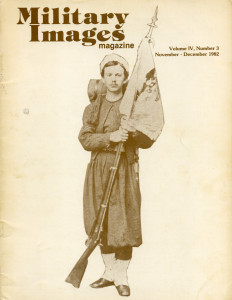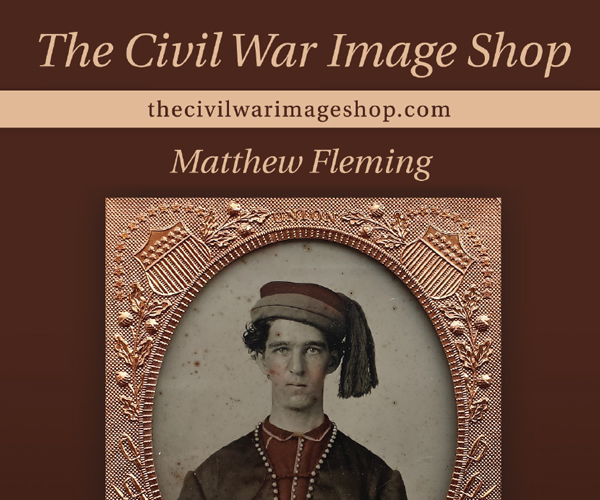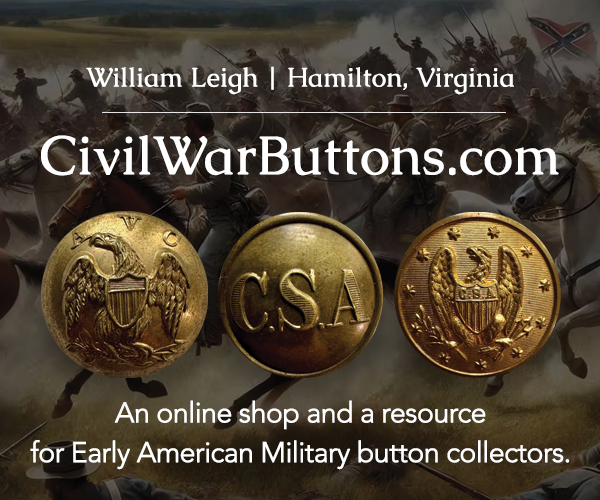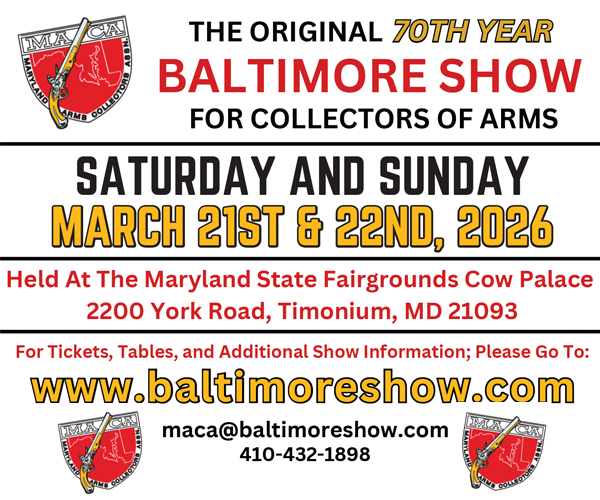The complete issue
Vol. 4, No. 3
(32 pages)
Print edition: Visit our store to check availability
Digital edition: Visit JSTOR.org to purchase
Subscribe to MI
Explore the MI Archives: Browse | Advanced search | Tutorial
Inside
Cover Image
An unidentified Zouave holds his rifle-musket with his unit guidon in the barrel.
Editor’s Desk (inside front cover)
The editor provides the results from the first reader survey. Covering items from basic reader demographics to the likes and dislikes of the readers, a good overview of who the readers of Military Images are and what they look for in the magazine is provided.
Mail Call (p. 2)
An appeal is made by the Society of Mexican War Historians to save the Palo Alto Battlefield site in Texas.
Passing in Review (p. 3)
Three publications are put forward for review in this issue. First is A Virginia Military Institute Album, 1839-1919: A Collection of Photographs and Manuscripts from the VMI Archives, Lexington as edited by Diane B. Jacobs and Judith Moreland Arnold. The volume combines photographic images of cadets and cadet life with diary entries, letters, and staff directives to give the reader a sense of what it was like to be a VMI cadet. Images of the New Market cadets are also included. Next for review is Ruggles’ Regiment: The 122nd New York Volunteers in the American Civil War by David Swinfen. This volume features illustrations made by a member of the 122nd after the war, although there is some controversy about the original illustrator. Each is marked W.E. Ruggles, but the name of Philip Ostrander has been partially erased. Finally, the book Lee: The Last Years by Charles Bracelen Flood follows Robert E. Lee from the surrender at Appomattox to his post-war life at Washington College, later to be named Washington and Lee, focusing on his decision to live as an example to his former soldiers.
Custer: A New Look by Mark Katz (pp. 4-6)
Seven previously unpublished images of General George Armstrong Custer are presented in this article, including a sixth-plate daguerreotype taken in 1857, before his arrival for study at West Point. Most of the images are from the end of the war, such as a pair of cartes de visite taken by Mathew Brady in October 1864. One of the images shows Custer with short hair, taken prior to his presentation of Confederate battle flags captured at Cedar Creek to Secretary of War Stanton in Washington. Another image shows is command on a porch in Stevensville, Virginia in November 1864, and purports to include his wife, Libby. Lastly is a series of three, with one being an image supposedly taken by Brady; the other two are cartes de visite showing Custer in the same chair as the Brady image, but the reverse credits John Golden, perhaps indicating some pirating.
Vignette: Charles Trotter, U.S.N. by Philip Katcher (p. 7)
After a six-month enlistment with Company B, 23rd Indiana Volunteers, engineer Charles Trotter was commissioned as Acting Third Engineer on the ironclad Chillicothe, which was being completed in Cincinnati. The article recounts several engineering tasks that the crew had to undertake to make the novel construction of the Chillicothe work, and then describes some of the wartime challenges faced by Trotter and other members of her crew as part of the fleet under the command of Admiral David Porter during the Vicksburg campaign in 1863, the expedition along the Red River in 1864, and other work in the Western navy.
On the Field at Chickamauga by Robert H. Hannaford (pp. 8-9)
Edited by Robert F. Russell, this article features a letter written by Private Hannaford of Company C, 93rd Ohio Volunteer Infantry Regiment of the Army of the Cumberland. He was hospitalized as a prisoner in June 1864 and wrote a detailed letter describing his experiences during the Battle of Chickamauga. He described his feelings approaching the fighting, and wrote about the charge by Colonel Baldwin of the 6th Indiana Brigade, who took the unit flag and galloped towards the Rebels, saying, “(i)t was more than the boys could stand to see the old flag leave us and all turned an charged down the hill…” Hannaford was shot in the thigh soon thereafter, was captured and liberated of his coffee, and then his hat. He described his treatment under the Confederates, eventually being brought to a field hospital by Captain Bacon of Bragg’s Ordinance Train. After not being tended to for 12 days and nights, Hannaford was taken to Ringgold, from where he wrote the letter.
U.S. Army Uniforms of the Civil War, Part VI: Zouaves and Chasseurs by Michael J. McAfee (pp. 10-15)
The article gives an overview of the history of the Zouaves in France, which were popularized in the United States through engravings and prints. A Chicago drill team, “The United States Zouave Cadets” was formed by Elmer Ellsworth; their tour of the U.S. in 1860 resulted in the adoption of Zouave dress by many militia. When the Civil War broke out in 1861, many of these same militia groups kept these influences, creating Zouave units in both Federal and Confederate armies. In a collection of 21 carte de visite images, the author illustrates variations in Zouave and the slightly similar French chasseur uniforms favored by some Union volunteer militia units.
Warriors in Baggy Pants: A Photographic Album of American Zouaves and Chasseurs by Carol Villa (pp. 16-26)
A collection of 25 individual and group images of soldiers wearing Zouave and chasseur uniforms drawn from reader submissions to Military Images is presented, starting with a photograph of “The San Antonio Zouaves” of Company G, 1st Texas Infantry as they prepared to take on garrison duty in Cuba after the Spanish-American War in 1898. Various Federal units are featured, as well as one unidentified member of the Charleston Zouaves, wearing a kepi with the palmetto symbol of South Carolina, and a European Papal Guard Zouave. This pictorial article allows the reader to view the many variations on the Zouave and chasseur uniforms discussed in the previous article.
Stragglers (pp. 27-30)
Musicians from the 1925 11th Coast Artillery begin the “Stragglers” feature in this issue, showing the unit’s 7’2” drum major and one of the musicians who had a height of 4’11” next to a photograph of a very small boy dressed in the 1905 Colorado National Guard uniform. The two pages show soldiers sharing food and drink and camaraderie, along with the good wishes of the MI staff for the New Year. The feature ends with two images showing unusual insignia.
Back Image
A rare sixth-plate tintype shows a different image of Lookout Mountain, which saw a great deal of photography during the Civil War. This image shows the placement of a camera and a make-shift darkroom, with the photographer or his assistant sitting on one of the unusual rocks above.
































